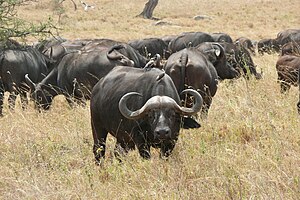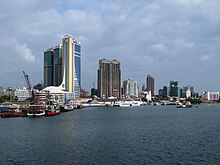Portal:Tanzania
 The Tanzania Portal
Tanzania, officially the United Republic of Tanzania, is a country in East Africa within the African Great Lakes region. It is bordered by Uganda to the northwest; Kenya to the northeast; the Indian Ocean to the east; Mozambique and Malawi to the south; Zambia to the southwest; and Rwanda, Burundi, and the Democratic Republic of the Congo to the west. Mount Kilimanjaro, Africa's highest mountain, is in northeastern Tanzania. According to the 2022 national census, Tanzania has a population of nearly 62 million, making it the most populous country located entirely south of the equator. Many important hominid fossils have been found in Tanzania, such as 6-million-year-old Pliocene hominid fossils. In the Stone and Bronze Age, prehistoric migrations into Tanzania included Southern Cushitic speakers who moved south from present-day Ethiopia; Eastern Cushitic people who moved into Tanzania from north of Lake Turkana about 2,000 and 4,000 years ago; and the Southern Nilotes, including the Datoog, who originated from the present-day South Sudan–Ethiopia border region between 2,900 and 2,400 years ago. These movements took place at about the same time as the settlement of the Mashariki Bantu from West Africa in the Lake Victoria and Lake Tanganyika areas. In the late 19th century, the mainland came under German rule as German East Africa, and this was followed by British rule after World War I when it was governed as Tanganyika, with the Zanzibar Archipelago remaining a separate colonial jurisdiction. Following their respective independence in 1961 and 1963, the two entities merged in 1964 to form the United Republic of Tanzania. Tanganyika joined the British Commonwealth and Tanzania remains a member of the Commonwealth as a unified republic. Tanzania is mountainous and densely forested in the north-east, where Mount Kilimanjaro, the highest mountain in Africa and the highest single free-standing mountain above sea level in the world, is located. Three of Africa's Great Lakes are partly within Tanzania. To the north and west lie Lake Victoria, Africa's largest lake, and Lake Tanganyika, the continent's deepest lake, known for its unique species of fish. To the south lies Lake Malawi. The eastern shore is hot and humid, with the Zanzibar Archipelago just offshore. The Menai Bay Conservation Area is Zanzibar's largest marine protected area. The Kalambo Falls, located on the Kalambo River at the Zambian border, is the second-highest uninterrupted waterfall in Africa. Tanzania is one of the most visited tourist destinations for safaris. Selected article -The economy of Tanzania is a lower-middle income economy that is overwhelmingly dependent on agriculture. Tanzania's economy has been transitioning from a planned economy to a market economy since 1985. Although total GDP has increased since these reforms began, GDP per capita dropped sharply at first, and only exceeded the pre-transition figure in around 2007. Following the rebasing of the economy in 2014, the GDP increased by a third to $41.33 billion. (Full article...)General images -The following are images from various Tanzania-related articles on Wikipedia.
This month in Tanzanian history
Wildlife of Tanzania - Credit: Haplochromis
The African buffalo, affalo or cape buffalo (Syncerus caffer) is a large African bovid. It is not closely related to the slightly larger wild Asian water buffalo, but its ancestry remains unclear. Owing to its unpredictable nature which makes it highly dangerous to humans, it has not been domesticated, unlike its Asian counterpart, the domestic Asian water buffalo. Did you know ...
CategoriesWikiProjectsRecognised contentSelected panorama -Skyline of the Dar es Salaam city center.
Uganda–Tanzania War -Articles here focus upon aspects of the Uganda–Tanzania War. These are all Good articles that meet a core set of high editorial standards.
The Battle of Masaka (Kiswahili: Mapigano ya Masaka) was a battle of the Uganda–Tanzania War that took place on 23 and 24 February 1979 in the town of Masaka, Uganda. Following artillery bombardment, most of the Ugandan government forces fled and Tanzanian and Ugandan rebel forces captured the town. Colonel Idi Amin had seized power in a military coup in Uganda in 1971 and established a brutal dictatorship. Seven years later he attempted to invade Tanzania to the south. Ugandan troops occupied the Kagera Salient and subsequently murdered local civilians and destroyed property. The attack was eventually repulsed, and Tanzanian President Julius Nyerere, unsatisfied with Amin's refusal to renounce his claims to Tanzanian territory and the international community's failure to strongly condemn the invasion, ordered his forces to advance into southern Uganda with the aim of capturing the towns of Masaka and Mbarara. (Full article...)TopicsSelected picture - Credit: Muhammad Mahdi Karim
A farmer walks towards sisal plantations in the outskirts of Morogoro, Tanzania. The Uluguru Mountains can be seen in the background. Tanzania is the world's fourth largest sisal producer. It is traditionally used for making rope, twine, paper, wall coverings and carpets. ...Archive — Nominations
Related portalsThings you can doAssociated WikimediaThe following Wikimedia Foundation sister projects provide more on this subject:
Discover Wikipedia using portals | ||||








































































